It looks like you're using an Ad Blocker.
Please white-list or disable AboveTopSecret.com in your ad-blocking tool.
Thank you.
Some features of ATS will be disabled while you continue to use an ad-blocker.
share:
reply to post by AtroxLux
Thanks so much for joining the thread. I did download the book you suggested.
Sorry I have been gone from the thread a day or so...I do want to go back & look
at the"Tuning Fork"...We have always had a tuning fork in music...also all of the
PICTures I have seen posted so far except 1 (I think) does look like a tuning fork.
The other looks like a emasculator or a hoof checker, or a surgery instrument as in a retractor,
sorry about not being totally prepared at the moment, I feel so far behind. I apologize for not
re-posting photos at the moment been busy with our 20" of snow over night & will end with
with~ 22 - 24"...way beyond our norm.
Anyway the original "Tuning Fork" looks like nothing in comparison to the 2nd...
meaning the original looks like an actual tuning fork. Sorry I hope I made some sense.
Cheers
Ektar
I am so excited that your thread is still moving on Beansi!
Thanks so much for joining the thread. I did download the book you suggested.
Sorry I have been gone from the thread a day or so...I do want to go back & look
at the"Tuning Fork"...We have always had a tuning fork in music...also all of the
PICTures I have seen posted so far except 1 (I think) does look like a tuning fork.
The other looks like a emasculator or a hoof checker, or a surgery instrument as in a retractor,
sorry about not being totally prepared at the moment, I feel so far behind. I apologize for not
re-posting photos at the moment been busy with our 20" of snow over night & will end with
with~ 22 - 24"...way beyond our norm.
Anyway the original "Tuning Fork" looks like nothing in comparison to the 2nd...
meaning the original looks like an actual tuning fork. Sorry I hope I made some sense.
Cheers
Ektar
I am so excited that your thread is still moving on Beansi!
beansidhe
reply to post by stormcell
A seahorse or a water horse?
The Kelpie is the supernatural shape-shifting water horse that haunts the rivers and streams of Scotland. It is probably one of the best known of Scottish water spirits and is often mistakenly thought to haunt lochs, which are the reserve of the Each Uisge. The creature could take many forms and had an insatiable appetite for humans; its most common guise was that of a beautiful tame horse standing by the riverside - a tempting ride for a weary traveller. Anybody foolish enough to mount the horse - perhaps a stranger unaware of the local traditions - would find themselves in dire peril, as the horse would rear and charge headlong into the deepest part of the water, submerging with a noise like thunder to the travellers watery grave. The Kelpie was also said to warn of impending storms by wailing and howling, which would carry on through the tempest.
Mysterious Britain
I think, stormcell, that you're onto something there.
As far as geography is concerned, I think that is an absolutely brilliant suggestion, and could well tie into the Z shape, as a motif, a reminder.
Etruscans were really big on these Sea horses.
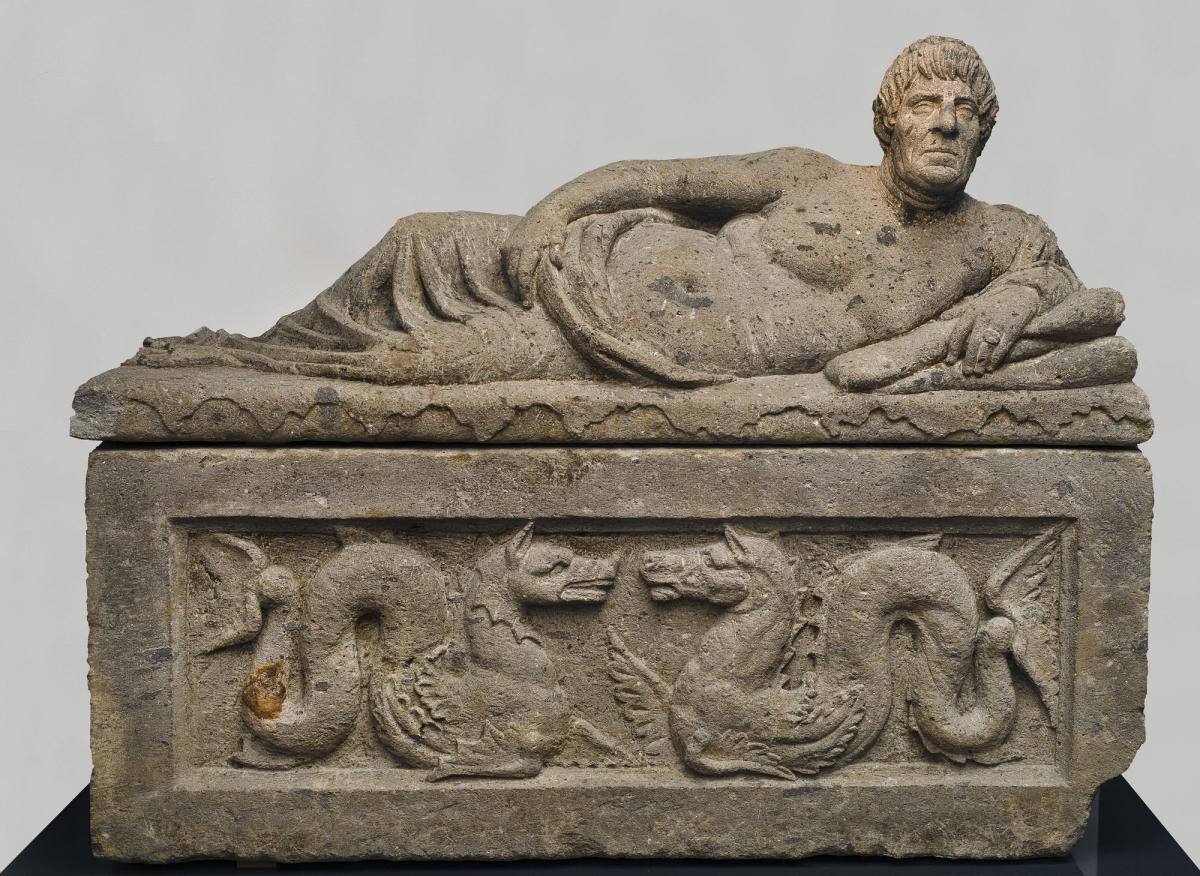
Something doesn't sit right with me regarding the z-rod and v-rod. If they were indeed representative of tools used by masons, then how come the
Picts never built anything substantial? For the most part they lived underground and in hastily built round hovels. There are certainly no right
angles in a round house.



I'm more inclined to believe they are broken arrows and spears, symbolising something, possibly death or paying homage to an elder or respected opponent. Or possibly recounting the events of a battle.
These stones in particular scream 'battle report' at me.





I'm more inclined to believe they are broken arrows and spears, symbolising something, possibly death or paying homage to an elder or respected opponent. Or possibly recounting the events of a battle.
These stones in particular scream 'battle report' at me.


reply to post by Ramcheck
Hi Ramcheck!
You could be right about the Z-rod and the 'battle report'. Battle depictions certainly were common on these stones. In fact the Sumerian symbol for weapon is a Z, I'm sure I saw that last night somewhere!
I hear what you're saying about the compasses, and apologies for not being clearer - this thread's so packed with information, I should be doing a better job of 'sieving' it.
The reason I was wondering about the builder's and architect's link came from this report:
The Independent
I think a lot of our thinking about the Picts has been tarnished by the notion that they were somehow ignorant savages.
ETA: Since the Z rod mostly appears paired with another symbol, such as over a notched rectangle, or double disc, are you suggesting that it could signify death, or defeat? That's a great idea! Luxus already mentioned that he thought it looked like it represented the otherworld.
Hi Ramcheck!
You could be right about the Z-rod and the 'battle report'. Battle depictions certainly were common on these stones. In fact the Sumerian symbol for weapon is a Z, I'm sure I saw that last night somewhere!
I hear what you're saying about the compasses, and apologies for not being clearer - this thread's so packed with information, I should be doing a better job of 'sieving' it.
The reason I was wondering about the builder's and architect's link came from this report:
A study of one the most important archaeological discoveries in Scotland for 30 years, a Pictish monastery at Portmahomack on the Tarbat peninsula in Easter Ross, has found that they were capable of great art, learning and the use of complex architectural principles. And, in a discovery described as "astonishing, mind-blowing" by architectural historians, it appears that the people who built the monastery did so using the proportions of "the Golden Section", or "Divine Proportion" as it became known during the Renaissance hundreds of years later. This ratio of dimensions, 1.618 to one, appears in nature, such as in the spiral of seashells, and the faces of people considered beautiful, such as Marilyn Monroe. It can be seen in Notre Dame Cathedral in Paris, the Alhambra palace of Granada in Spain, the Acropolis in Athens and the Egyptian Pyramids, but was thought to have been too advanced for the Picts.’
The Independent
I think a lot of our thinking about the Picts has been tarnished by the notion that they were somehow ignorant savages.
ETA: Since the Z rod mostly appears paired with another symbol, such as over a notched rectangle, or double disc, are you suggesting that it could signify death, or defeat? That's a great idea! Luxus already mentioned that he thought it looked like it represented the otherworld.
edit on 14-2-2014 by beansidhe because: Ramcheck's good idea filtered slowly through my brain
reply to post by AtroxLux
The avatar is gorgeous, I love the earth colours.
Ha ha ha, ATS has that effect on me too! I suddenly run up the stairs, to grab a book that I've just remembered which has a tenuous link!
The Gundestrup Cauldron is strangely similar, which makes me think about trading links and the contact these cultures had with each other.
The avatar is gorgeous, I love the earth colours.
Thanks to you lot, I now look like some wizard surrounded by books and I keep getting asked what I'm doing
Ps...now that I have looked at the Gundestrup Cauldron again, I can see a lot of similar imagery to that of the Pictish stones, the animals in particular.
Ha ha ha, ATS has that effect on me too! I suddenly run up the stairs, to grab a book that I've just remembered which has a tenuous link!
The Gundestrup Cauldron is strangely similar, which makes me think about trading links and the contact these cultures had with each other.
Logarock
Some Etruscan work.edit on 13-2-2014 by Logarock because: n
Now that is similar - the double disc, the 'panels'. Once you start looking into the similarities in these art works, it is incredible how cultures seem to share logos and motifs. There must have been more contact with each other than we (well, me) previously thought. I don't suppose anyone's deciphered that Etruscan stone, have they?
reply to post by Ektar
You did make sense, Ektar! Good to see you back!
Once I went back to look closely, I noticed that they have drawn tongs on one stone:
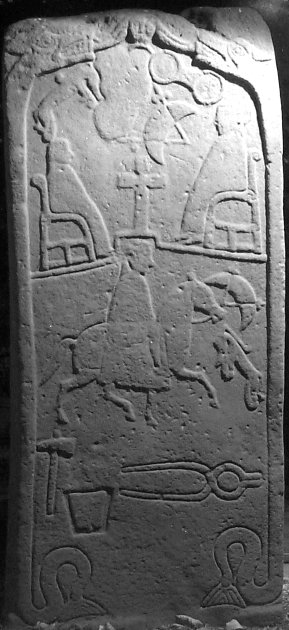
Which do in fact look very different to the others:
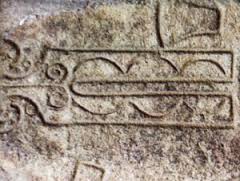
They could represent the same thing, I'm just not sure.
You did make sense, Ektar! Good to see you back!
Once I went back to look closely, I noticed that they have drawn tongs on one stone:

Which do in fact look very different to the others:

They could represent the same thing, I'm just not sure.
Ramcheck
These stones in particular scream 'battle report' at me.
That is certainly what they are. Probably a war of subjugation perpetrated on the locals by outsiders. The location and spread of the stones suggests that these folks were intruders coming in and marking a territory for themselves.
I may be wrong but we don't find these sort of monuments within Britain from the same time frame or before. I don't mean simply Pictish but anybody. Maybe some Roman?
It should also be considered that these stones predate Roman invasion and are really not Pictish per se but are called Pictish because of their association with the locals. The description of Pictish people by the Romans pretty much describe much of Britain at the time.
I think the example above may be successive waves of graffiti.
The neolithic age saw standing stones erected all over the old world, 3K-1800 BC
The pictish carvings date from a later age
And the horsemen probably from saxon and norman invasions 400-1200 AD..
Riding horses (not even bothering with chariots for small ponies) fits in with germanic invaders, not picts.
The neolithic age saw standing stones erected all over the old world, 3K-1800 BC
The pictish carvings date from a later age
And the horsemen probably from saxon and norman invasions 400-1200 AD..
Riding horses (not even bothering with chariots for small ponies) fits in with germanic invaders, not picts.
reply to post by tovenar
It's not agreed by archaeologists at this point whether or not they used chariots:
Scots history online
Given that Roman writers sometimes used the names Caledonii and Picts interchangeably, it's hard to get a detailed picture of the era. We know they had horses from the stone carvings they left.
Waves of graffiti is interesting, because we also know that the back of class 1 stones were re-carved with Christian iconography in the early centuries of Christianity
It's not agreed by archaeologists at this point whether or not they used chariots:
Similarities in art often occur between the Irish and the Pictish. However, any literature produced by the Picts, besides a list of kings, has been lost to us and we only have one visual example of a chariot in Pictish art. The Meigle #10 stone, sadly now lost, is our only glimpse of a "Pictish" chariot. At one point the stone rested on a mound in the Meigle Churchyard; today we only have a sketch (found in Allen & Anderson’s, The Early Christian Monuments of Scotland) of the original stone. Two, side-by-side, horses with braided tails draw the Meigle chariot. There is a seated driver at the front and two passengers, sitting one in front of the other, behind the driver. The chariot has an awning stretched over the two passengers and the wheel, underneath the passengers, has twelve spokes. It is in question whether the chariot on the stone represents a Pictish chariot, a Roman chariot or the artist’s perception of a Biblical times chariot....Tacitus claimed that the Caledonians used chariots at Mon Grapius in 84 AD. The last recorded use of chariots in a Celtic battle was by the Dal Riadans at the battle of Moin Dairi Lothair in 563 AD.
Scots history online
Given that Roman writers sometimes used the names Caledonii and Picts interchangeably, it's hard to get a detailed picture of the era. We know they had horses from the stone carvings they left.
Waves of graffiti is interesting, because we also know that the back of class 1 stones were re-carved with Christian iconography in the early centuries of Christianity
edit on 14-2-2014 by beansidhe because: (no reason given)
reply to post by tovenar
This is an important issue tbf. Horses and chariots are mentioned by some writers and not by others, the only evidence we have is on those stones they left us. I would have thought personally they depicted Romans, given the helmet shapes we associate with them today, you can make out the Galea quite clearly on some carvings.
This is an important issue tbf. Horses and chariots are mentioned by some writers and not by others, the only evidence we have is on those stones they left us. I would have thought personally they depicted Romans, given the helmet shapes we associate with them today, you can make out the Galea quite clearly on some carvings.
reply to post by Ramcheck
Look at the Hilton of Cadboll stone from Ross and Cromarty:
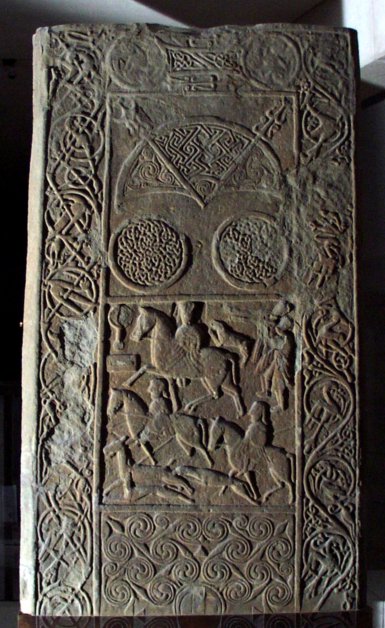
As far as I know, the Romans were not considered a threat as far north as that. The stone seems to show a hunting scene, rather than a battle. There seems to be no definitive explanation for the symbols- as soon as you think you have a handle on one of them, something on another stone seems to suggest otherwise. That's not to say you're not right about identifying the Romans, just wanted to compare it to a similar stone where Romans were unlikely to be such a threat. Although, of course, it could be telling a story from another part of Pictland, but then why add the hounds and deer?
This is not a criticism of your interpretation, the stones are just confusing the hell out of me!
I love your avatar, by the way!
Look at the Hilton of Cadboll stone from Ross and Cromarty:

As far as I know, the Romans were not considered a threat as far north as that. The stone seems to show a hunting scene, rather than a battle. There seems to be no definitive explanation for the symbols- as soon as you think you have a handle on one of them, something on another stone seems to suggest otherwise. That's not to say you're not right about identifying the Romans, just wanted to compare it to a similar stone where Romans were unlikely to be such a threat. Although, of course, it could be telling a story from another part of Pictland, but then why add the hounds and deer?
This is not a criticism of your interpretation, the stones are just confusing the hell out of me!
I love your avatar, by the way!
Can't disagree with that it's surely a hunting scene. That's probably my favourite stone of them all tbh.
I didn't mean to sound condescending by the way when I said you can see the Galea on some, that's just the way I interpret particular ones. Also who is to say that tribes like the Venicones for example - as recorded by Ptolmy - didn't wear similar head gear? Incidentally the translation of Venicones apparently means 'hunting hounds' and they operated in the Dundee area, far enough North and roughly at the same time, to have crossed paths with the makers of that particular stone. Shot in the dark but it may be a marker for a particular tribes hunting grounds.
Thanks, about the avatar.
I didn't mean to sound condescending by the way when I said you can see the Galea on some, that's just the way I interpret particular ones. Also who is to say that tribes like the Venicones for example - as recorded by Ptolmy - didn't wear similar head gear? Incidentally the translation of Venicones apparently means 'hunting hounds' and they operated in the Dundee area, far enough North and roughly at the same time, to have crossed paths with the makers of that particular stone. Shot in the dark but it may be a marker for a particular tribes hunting grounds.
Thanks, about the avatar.
beansidhe
reply to post by Ramcheck
Look at the Hilton of Cadboll stone from Ross and Cromarty:
Notice on this Narmer Platte, which is at least several thousand years older than conjectures about these Pict stones, and is also a stone memorializing conquest, that Narmers name icon is in front of him. Now notice in the Pict stone what looks clearly like the same sort of personal icon in front of the top rider.
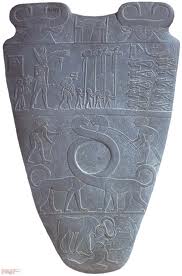
Here is a close up.
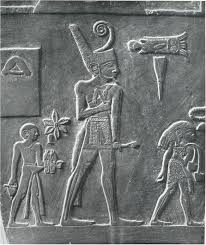
Now this is just speculation but that head gear on the top Pict rider looks strange like something a woman would wear. But look at that headgear......(plus it looks like rider is riding side saddle, her feet represented on one side only, the back side, while other riders legs are shown.)
Now compare to below...worn by the ever lovely Nefertiti.

reply to post by Logarock
Ooh, ooh and her (it does seem like a woman) pictures are a mirror and rectangle. That could be her name, or her clan!
I'm going to check the other stones with mirrors.
Nefertiti? It does look suspiciously like her, I have to admit. Were these commemorative stones, of events in other lands then? Or boundary markers that showed the lineage of the group?
Ooh, ooh and her (it does seem like a woman) pictures are a mirror and rectangle. That could be her name, or her clan!
I'm going to check the other stones with mirrors.
Nefertiti? It does look suspiciously like her, I have to admit. Were these commemorative stones, of events in other lands then? Or boundary markers that showed the lineage of the group?
Ramcheck
Can't disagree with that it's surely a hunting scene. That's probably my favourite stone of them all tbh.
I didn't mean to sound condescending by the way when I said you can see the Galea on some, that's just the way I interpret particular ones. Also who is to say that tribes like the Venicones for example - as recorded by Ptolmy - didn't wear similar head gear? Incidentally the translation of Venicones apparently means 'hunting hounds' and they operated in the Dundee area, far enough North and roughly at the same time, to have crossed paths with the makers of that particular stone. Shot in the dark but it may be a marker for a particular tribes hunting grounds.
Thanks, about the avatar.
You didn't seem condescending at all - I usually sound like an over-enthusiastic moron with far too much punctuation!!!!!!
I didn't know Venicones meant that, and that is particularly interesting, because (I'm assuming) Venicones sounds like a name Ptolemy would give the people, in that it sounds Latin and not native. These groups must have got on reasonably well with each other, since they share the same symbols from the very north right down to Perth and Dundee.
I assumed they were depicting themselves, but they could just as easily be saying 'we fought and won against these invaders' on their stones.
The only thing I am sure about, at this point, is that they were a far more sophisticated people than history has credited them as being.
Here is another of the stones from Meigle, which may be showing the same story, although it is certainly more bizarre.
The woman, the procession/hunt, the mirror 'naming' her:

The woman, the procession/hunt, the mirror 'naming' her:

reply to post by Logarock
I too was wondering if the rider was sitting side-saddled, great catch!
Here's my 2 cents, look to the right of the top rider & there are two
horn blowers which are present during hunts, especially the fox & hound
hunts.
Cheers
Ektar
I too was wondering if the rider was sitting side-saddled, great catch!
Here's my 2 cents, look to the right of the top rider & there are two
horn blowers which are present during hunts, especially the fox & hound
hunts.
Cheers
Ektar
reply to post by AtroxLux
If a Rosetta stone is going to be found, it might just be found at the Wemyss Bay cave excavation, which Thorneblood mentioned:
They're going to release their findings in April (can't wait!)
This is what they already have:
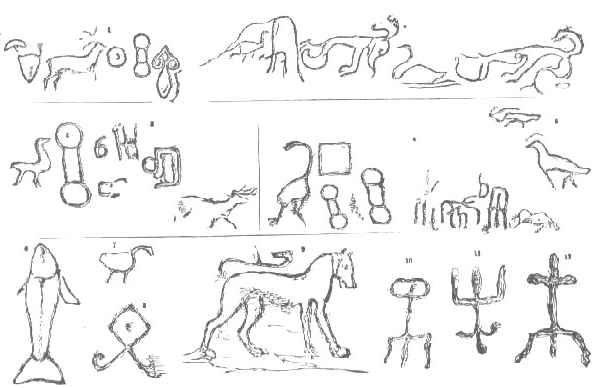


If a Rosetta stone is going to be found, it might just be found at the Wemyss Bay cave excavation, which Thorneblood mentioned:
Wemyss Caves hold the largest collection of Pictish carvings in north-west Europe. However, they are under constant threat from coastal erosion. The project, a joint effort between St Andrews University, York Archaeological Trust and a local community group, aims to scan the images and save them for future generations. The academics will showcase their findings online to reach a wider audience.
They're going to release their findings in April (can't wait!)
This is what they already have:



new topics
-
Where should Trump hold his next rally
Politicians & People: 29 minutes ago -
Shocking Number of Voters are Open to Committing Election Fraud
US Political Madness: 1 hours ago -
Gov Kristi Noem Shot and Killed "Less Than Worthless Dog" and a 'Smelly Goat
2024 Elections: 1 hours ago -
Falkville Robot-Man
Aliens and UFOs: 2 hours ago -
James O’Keefe: I have evidence that exposes the CIA, and it’s on camera.
Whistle Blowers and Leaked Documents: 2 hours ago -
Australian PM says the quiet part out loud - "free speech is a threat to democratic dicourse"...?!
New World Order: 3 hours ago -
Ireland VS Globalists
Social Issues and Civil Unrest: 4 hours ago -
Biden "Happy To Debate Trump"
2024 Elections: 4 hours ago -
RAAF airbase in Roswell, New Mexico is on fire
Aliens and UFOs: 4 hours ago -
What is the white pill?
Philosophy and Metaphysics: 6 hours ago
top topics
-
A Warning to America: 25 Ways the US is Being Destroyed
New World Order: 14 hours ago, 21 flags -
Blast from the past: ATS Review Podcast, 2006: With All Three Amigos
Member PODcasts: 6 hours ago, 11 flags -
Mike Pinder The Moody Blues R.I.P.
Music: 7 hours ago, 8 flags -
Biden "Happy To Debate Trump"
2024 Elections: 4 hours ago, 8 flags -
Australian PM says the quiet part out loud - "free speech is a threat to democratic dicourse"...?!
New World Order: 3 hours ago, 7 flags -
James O’Keefe: I have evidence that exposes the CIA, and it’s on camera.
Whistle Blowers and Leaked Documents: 2 hours ago, 6 flags -
What is the white pill?
Philosophy and Metaphysics: 6 hours ago, 5 flags -
Ireland VS Globalists
Social Issues and Civil Unrest: 4 hours ago, 4 flags -
RAAF airbase in Roswell, New Mexico is on fire
Aliens and UFOs: 4 hours ago, 4 flags -
Putin, Russia and the Great Architects of the Universe
ATS Skunk Works: 10 hours ago, 3 flags
active topics
-
Biden "Happy To Debate Trump"
2024 Elections • 37 • : WeMustCare -
University of Texas Instantly Shuts Down Anti Israel Protests
Education and Media • 302 • : Xtrozero -
Shocking Number of Voters are Open to Committing Election Fraud
US Political Madness • 2 • : xuenchen -
Candidate TRUMP Now Has Crazy Judge JUAN MERCHAN After Him - The Stormy Daniels Hush-Money Case.
Political Conspiracies • 810 • : Annee -
Where should Trump hold his next rally
Politicians & People • 3 • : theatreboy -
Do you ever just get "bored" of everything?
Rant • 22 • : JonnyC555 -
-@TH3WH17ERABB17- -Q- ---TIME TO SHOW THE WORLD--- -Part- --44--
Dissecting Disinformation • 701 • : Thoughtful3 -
This is our Story
General Entertainment • 2 • : ByeByeAmericanPie -
Mike Pinder The Moody Blues R.I.P.
Music • 2 • : DontTreadOnMe -
The functionality of boldening and italics is clunky and no post char limit warning?
ATS Freshman's Forum • 14 • : Encia22


